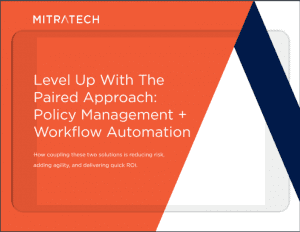Learning a New Policy Management Solution Shouldn’t be a Headache
Welcome to part four of this six-part series, where we are exploring how ease of use is paramount when choosing a policy management solution. So far, we have looked at ease of use for employees, policy owners and administrators.
Today we’re going to talk about the importance of making sure that learning about a policy management solution is simple, effective and tailored to the organisation’s requirements.
Elliot Masie, President of the MASIE Centre Learning & Technology Think Tank, once said:
“It is relatively easy to change your technology or to create new business processes, but the difficult part in any change initiative is the people. Changing people’s attitudes and behaviors is the greatest challenge in implementing new software systems, and one that can be easily overlooked. Not following through on the human component of software implementation can result in increased costs and reduced productivity through sub-optimal performance, more errors and longer implementation times. The greatest cost, however, can be the failure of the organization to implement the technology at all.”
I thought it would be useful to explore how training should be managed for each of the different types of users of a policy management solution:
Employees:
Do you really want to have to train every employee on how to access and use the solution? This could be a very time-consuming task, especially with employees in multiple locations and time zones. You need to choose a solution that is intuitive to use, so that all you need to do is send a communication to the employees to let them know the new location of the organisation’s policies, and that they can expect to receive notifications as and when new compliance tasks (such as reading an update to a policy) need to be completed.
Also, what about new employees? Wouldn’t it be great if they could easily and intuitively sign up to the relevant policies on their first day with no training – making their onboarding process easier and more streamlined?
Policy Owners:
Your employees who own the organisation’s policies will need to learn more about the tool, as they will be responsible for managing and distributing the policies, but you don’t want this to involve days or weeks of training. These employees still have to conduct business as usual on a daily basis, so the training should not be onerous and time-consuming. Importantly, it should be tailored to the organisation’s requirements and to why you bought the policy management solution in the first place.

You need to understand how this training will be delivered so it can best fit in with your needs. Is it on-site training, either at your offices or at the vendor’s? Can any training be done remotely? How does training work for policy owners based in different locations or timezones? How would new policy owners get to know the software? I think a good approach is if the vendor uses the “train-the-trainer” approach so, as and when staff changes, you have the tools to be able to train any new policy owners on how you have implemented the solution.
Administrators:
Administrators will be responsible for various tasks, such as making sure that policy owners have the correct permissions or that the correct recipient lists are created for distributing policies. It is important that these administrators receive training how the organisation is going to be using the solution so that they can ensure it is maintained correctly. Again, this should involve only be a few hours of training on the specific information that they need in order to fulfill their responsibilities.
Your Policy Management vendor should make things easy, too
When researching policy management tools, it’s smart to consider how the vendor will continue to support you long after the sale has come and gone. You need to choose a vendor who understands why you have bought the software, what you are looking to achieve and what your objectives are so the training is relevant and useful.
You also want to make sure that you can be up and running with the solution with the minimal amount of relevant training, therefore making the most of your investment. Finally, implementing a policy management solution is not just about training but also about education, so you are given the tools to be successful, and the knowledge you need in using them to drive success across the organisation.
[bctt tweet=”Be picky about who fits your business: As of 12/2019, there were 312 ‘policy management’ startups on AngelList.” via=”yes”]
Next week, in part five of this series, we’re going to explore deploying a new policy management solution, and why the onboarding of the solution should be a straightforward and easy process.




